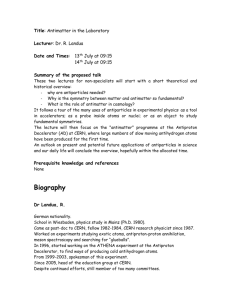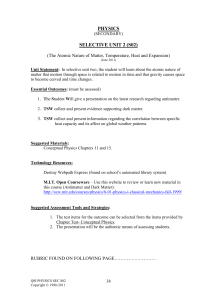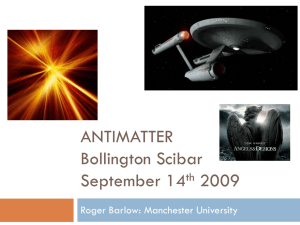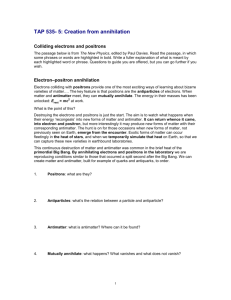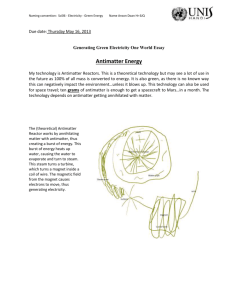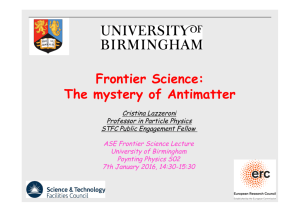Introduction - Indico
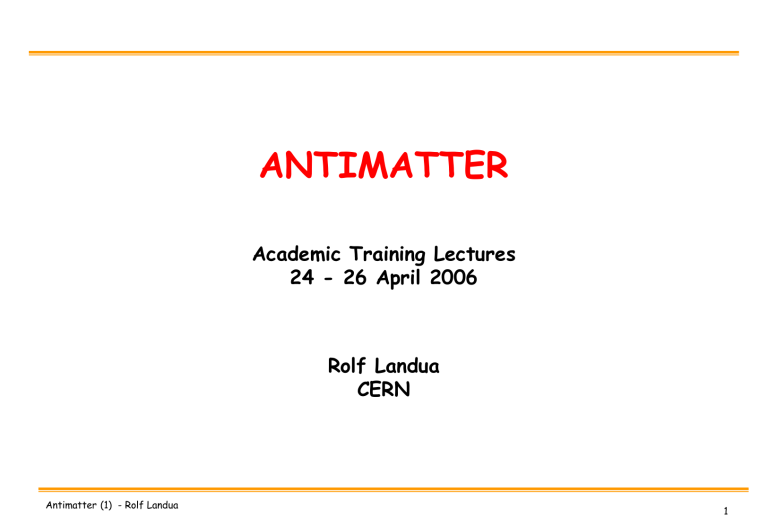
Antimatter (1) - Rolf Landua
ANTIMATTER
Academic Training Lectures
24 - 26 April 2006
Rolf Landua
CERN
1
Lecture Plan
I.
History of Antimatter
II.
Antimatter and the Universe
III. Production and trapping of antiparticles
IV.
Precision tests of particleantiparticle symmetry
V.
AD Physics and Antihydrogen
VI.
Antimatter technologies
Goal: Overview about theoretical concepts, experiments and technologies
Antimatter (1) - Rolf Landua
2
I. History - Overview
1905
Special relativity
1925
Quantum Mechanics
1927
Dirac Equation
1932
Positron
1956
Antineutron
1965
Antideuteron
1970
Anti-Helium-3
1978
Anti-Tritium
Primordial
Antimatter?
Anti-Stars?
Antimatter (1) - Rolf Landua
1955
Antiproton
1956-1980s:
Scattering, annihilation,
Meson spectroscopy
1980s-now:
W,Z, b,t physics
Technical developments
1970s
Accumulation + Cooling
1980s-now
Colliders (SppS, Tevatron)
1983-1996
LEAR
2000-now
Antiproton Decelerator
1948
Positronium
1996: Hot (v~c)
Antihydrogen
Trapping
Cold
Antihydrogen
3
Early ideas of antimatter
1897: J.J. Thompson discovers the electron
1898: The physicist Arthur Schuster writes to ‘Nature’ :
If there is negative electricity, why not negative gold , as yellow as our own ?
Antimatter (1) - Rolf Landua
4
1905: Relativity
All attempts to find a motion of e.g. the Earth with respect to the “ether” had failed. The speed of light had the same value independent of the relative velocity between source and observer.
Einstein:
1) No preferred inertial system
2) Speed of light always constant
Consequences:
Lorentz transformations of spacetime coordinates
(time dilation, space contraction)
Physical laws must ‘look the same’ in different inertial reference frame (Lorentz invariance): space and time coordinates are to be treated equally
Antimatter (1) - Rolf Landua
5
1905: Relativity
Lorentz invariance is guaranteed if laws of physics are written in terms of ‘invariant products of four-vectors’
Maxwell equations of electromagnetism are o.k.
(space and time coordinates are treated equally)
Newton’s law: not o.k.
need to modify definition of momentum
(define energy-momentum 4-vector (E,p))
Energy and momentum are related by:
E 2 = m 2 c 4 +p 2 c 4
Antimatter (1) - Rolf Landua
o.k.
m
2
t
2 r
G mM r
2 not o.k.
6
Speed of light limits the causal connection of events
Causal connection between two ‘events’ only within “light cone”
Antimatter (1) - Rolf Landua
Clear distinction between the
‘PAST’ and the ‘FUTURE’
(for any given observer)
7
Quantum Physics (1923-1925)
1913 (Bohr) Angular momentum quantized in atom
1923 (de Broglie) Particles have wave properties
1925 (Heisenberg) Uncertainty relation
1926 (Schr ö dinger*) Non-relativistic wave equation r
p
n
p
p
x
p
2
E
2 m
i
t
2
2 m
2
Particle described by probability amplitude (x)
Observables are described by operators acting on (x)
E
i
t p
h i
*Schr ö dinger also tried …
Antimatter (1) - Rolf Landua
E
2
p
2 m
2 2
2
t
2
2 2
m
2
… but could not solve ‘negative energy’ problem
8
Dirac equation (1) - Relativistic electrons?
Which equation describes a relativistic electron (c=1)?
Dirac: Take the ‘square root’ - and deal with negative solution
Linear equation, based on relativistic energy-momentum conservation
E
2 p
2 m
2
E
(
p )
m
i
t
i (
x
x
...)
m
Solution: , are 4x4 matrices (called “ g m ”)
has 4 components (“spinor”)
What does
stand for??
P.A.M. Dirac, Proc. Roy. Soc. A118, 351 (1928)
Antimatter (1) - Rolf Landua
9
Dirac equation (2) - Four components?
Electron had spin 1/2 (two ways of alignment in a magnetic field).
Description by a two-component Pauli ‘spinor’ (spin-up and spin-down).
But: had two spin 1/2 particles !
1
0
0
o r
0
1
0
e
- i m t
0
0
0
0
1
o r
0
0
0
e
+ i m t
0
1
These are the two spin states of an electron with positive energy
These are the two spin states of something (similar) with ‘negative’ energy ????
For moving electrons, the upper and lower components mix.
The ‘one-particle’ wave function describes now a multi-particle wave function
Dirac 1929: ‘negative’ energy states with positive charge = proton ??
Antimatter (1) - Rolf Landua
10
Dirac’s Interpretation: Holes in the vacuum
Dirac 1931: “Subsequent investigations, however, have shown that this particle necessarily has the same mass an an electron and also that, if it collides with an electron, the two will have a chance of annihilating one another … “
All negative energy states occupied by electrons.
‘Pauli exclusion principle’ prevents electrons to fall into the “Dirac sea” (otherwise t trans
~ 10 -8 sec).
Pair creation: By absorbing radiation (E≥ 2m), an electron can be lifted from negative to positive energy state. The remaining hole (absence of negative charge) behaves like a positive electron the positron.
Vacuum had become very complicated
(infinite zero-point energy, infinite charge)
Antimatter (1) - Rolf Landua
Proc. Roy. Soc. A133, 60 (1931)
11
Relativity + Quantum Mechanics = Antimatter
“Second quantization” - the electron (field) is no longer described by a wave function but an operator that creates and destroys particles. All energies are positive.
Richard Feynman
An electron can emit a photon at A, propagate a certain distance, and then absorb another photon at B.
Antimatter (1) - Rolf Landua
12
Antiparticles restore (micro-) causality
Quantum physics: the wave function is spread out over the Compton wave length ( c
= h/mc). t
c
= h/mc
“One observer’s electron is the other observer’s positron”.
The presence of antiparticles is necessary to restore the causal structure to the process seen in another inertial system.
Antimatter (1) - Rolf Landua
13
Positron discovery (1932)
Anderson used cloud chamber in a 15 kG magnetic field
CC had two parts, separated by a 6-mm lead plate.
Greater curvature of upper track indicates that particle entered the chamber from below.
This determines the positive charge of the particle.
From the track curvature and track length (= energy loss per cm) Anderson concluded that the positive charge of the particles is less than twice that of proton and the mass is less than twenty times the proton mass.
Antimatter (1) - Rolf Landua
C. D. Anderson. "The positive electron", Phys. Rev., 43, 491 (1933).
14
Positron discovery- why so late ?
A comment by Dirac on why the positron was not discovered until 1932
"Why did the experimentalists not see them? Because they were prejudiced against them .
The experimentalists had been doing lots of experiments where particles were moving along curved tracks in a magnetic field. ....
[They] sometimes saw the opposite curvature, and interpreted the tracks as electrons which happened to be moving into the source, instead of the positively charged particles coming out. That was the general feeling.
People were so prejudiced against new particles that they never examined the statistics of these particles entering the source to see that there were really too many of them." --
Dirac, in J. Mehra, ed. The Physicist's Conception of Nature, pg. 12.
Antimatter (1) - Rolf Landua
15
Discovery of the antiproton (1955)
But even in 1955, many prominent physicists remained doubtful if baryons would have antiparticles. After all, the magnetic moment of the proton (g = 5.58 ≠ 2) seemed to indicate that the proton was not a Dirac particle . As an example, Maurice Goldhaber bet against* the existence of the antiproton …
… and lost
(he gave Snyder 500 $ in November 1955).
*Hartland Snyder
(co-discoverer of the strong focussing method)
The energy of the Bevatron at Berkeley had been designed for the production of the antiproton and as built by Ernest Lawrence and his team.
Antimatter (1) - Rolf Landua
16
The final proof
Antimatter (1) - Rolf Landua
Antiproton annihilation
First symmetry tests - mass, charge agreed to ~10%
17
Segrè
Discovery of the antiproton (2)
Paper published in Nov 1955
Nobel prize (1959) for 50% of the collaboration
Chamberlain
Antimatter (1) - Rolf Landua
Tedious analysis ….
18
Antineutron, Antinuclei
Berkeley, 1956: Discovery of antineutron
( Cork, Lambertson, Piccioni, Wenzel ) using the ‘antiproton beam’ and charge-exchange reaction antiproton + proton ➝ antineutron + neutron
The produced antineutron was recognizable by its annihilation properties, forming a star in the cloud chamber that is very similar to an antiproton star.
CERN, 1965: Discovery of the anti-deuteron
( Massam, Muller, Righini, Schneegans, Zichichi)
The results reported imply the conclusion that a negative particle exists with mass equal to 1867 ± 80 MeV. The most simple interpretation of these data is to identify this particle with the anti-deuteron.
Antimatter (1) - Rolf Landua
19
CPT theorem
All Quantum Field Theories (including the Standard Model) are built upon:
1) Locality (no action at a distance)
2) Lorentz invariance (all inertial frames are equivalent)
3) Causality (no interaction between two spacetime points outside light cone)
4) Vacuum is the lowest energy state
( ➝ spin-statistics connection)
The ‘CPT theorem’ - based on these assumptions - states:
In a mirror world, where particles are replaced by their antiparticles, and where time runs backwards - all physical processes would be identical.
Particles and antiparticles have exactly equal masses, lifetimes, magnetic moments, etc.
Antimatter (1) - Rolf Landua
20
CPT theorem (cont’d)
However, the proof of the CPT theorem is based on further assumptions:
1) Point-like particles
2) Flat 4-D space time
[e.g. G. Barenboim et al., PLB 534 (2002) 106; O.W. Greenberg, PRL 89 (2002) 231602]
These assumptions are not necessarily valid at the Planck (or another fundamental) scale.
Several models speculate with CPT violation, induced by e.g.
Quantum Gravity (loss of unitarity through space-time foam/black holes)
String theory (spontaneous breaking of Lorentz symmetry)
Overview :
Antimatter (1) - Rolf Landua
CPT Violation - Theory and Phenomenology
(Nick Mavromatos, arXiv:hep-ph/0504143, 2005)
21
Direct comparison of stable particles and antiparticles
1) Compare relative precisions
(divide error by value)
Antimatter (1) - Rolf Landua
22
CPT symmetry (2)
2) Compare absolute values/errors in terms of energy/frequency
Hydrogen atom
1S-2S transition
Lamb shift (2s-2p)
Ground state HFS
• THERE IS NO “THEORY” OF CPT VIOLATION
• DIRECT TESTS CONFIRM CPT ~ 10 -12 LEVEL
• HYDROGEN - ANTIHYDROGEN COMPARISON PROMISING (< 10 -15 )
Antimatter (1) - Rolf Landua
23
Gravitation and Antimatter
Equivalence principle
No way to distinguish locally between gravitational potential and constant acceleration.
Experimental tests:
WEAK EQUIVALENCE PRINCIPLE
The world line of a freely falling test body is independent of its composition or structure.
Galileo, Huygens, Newton, Bessel,
Eotvos, Dicke; Eot-Wash (Seattle) m i
= m g with m/m < 10 -12
Argument in favour :
The masses of particles and antiparticles obey E = mc 2 . Since it is this energy that curves space, antimatter must have the same gravitational interaction as matter
Antimatter (1) - Rolf Landua
24
Gravitation is not constrained by CPT
Antimatter (1) - Rolf Landua
25
Non-Newtonian Gravitation?
BUT - THERE MAY BE DEVIATIONS FROM THE (WEAK) EQUIVALENCE PRINCIPLE
Newton gravity: Tensor force (graviton - spin 2) = attractive .
Non-Newtonian: Scalar force (spin 0) = attractive
Vector force (spin 1) = attractive or repulsive (changes sign for antimatter); may be of finite range
The additional components of the gravitational field would show up as a ‘5th force’ (searched for in the early 1990’s). The present limit on these components to ~ 10 -4 of the gravitational interaction for typical terrestrial distances.
Extended discussion for and against ‘antigravity’ in the literature, eg.
M. M. Nieto, T. Goldmann “Arguments against antigravity …”, Phys. Rep. 205 (1991) 221
P. Morrison, Approximate nature of physical symmetries, Am.J.Phys. 26 (1958) 358 (energy conservation)
L.I. Schiff, Sign of the gravitational mass of a positron, Phys. Rev. Lett. 1 (1958) 254 (vacuum polarization)
M.L. Good, K
2 o and the equivalence principle, Phys. Rev. 121 (1961) 311 (Ks regeneration)
Antimatter (1) - Rolf Landua
26
Antiparticle gravitation experiments have been attempted, but …
No measurement of gravitational effects on antiparticles has yet succeeded ..
(one controversial result by Witteborn + Fairbanks for positrons, and a failed attempt with antiprotons at LEAR).
Problems:
- Coulomb explosion
- Patch effect (mV/cm)
- Residual charges
(10 -7 eV ~ 1 electron at 1 m distance)
Solution:
Use neutral, stable system = antihydrogen
Antimatter (1) - Rolf Landua
27
Conclusion: Antimatter Gravity
Weak equivalence principle is well tested with ordinary matter*, but not at all with antimatter
* Overview: B.R. Heckel et al., Adv. Space Res. 25 (2000) 1125
Antimatter (1) - Rolf Landua
28
